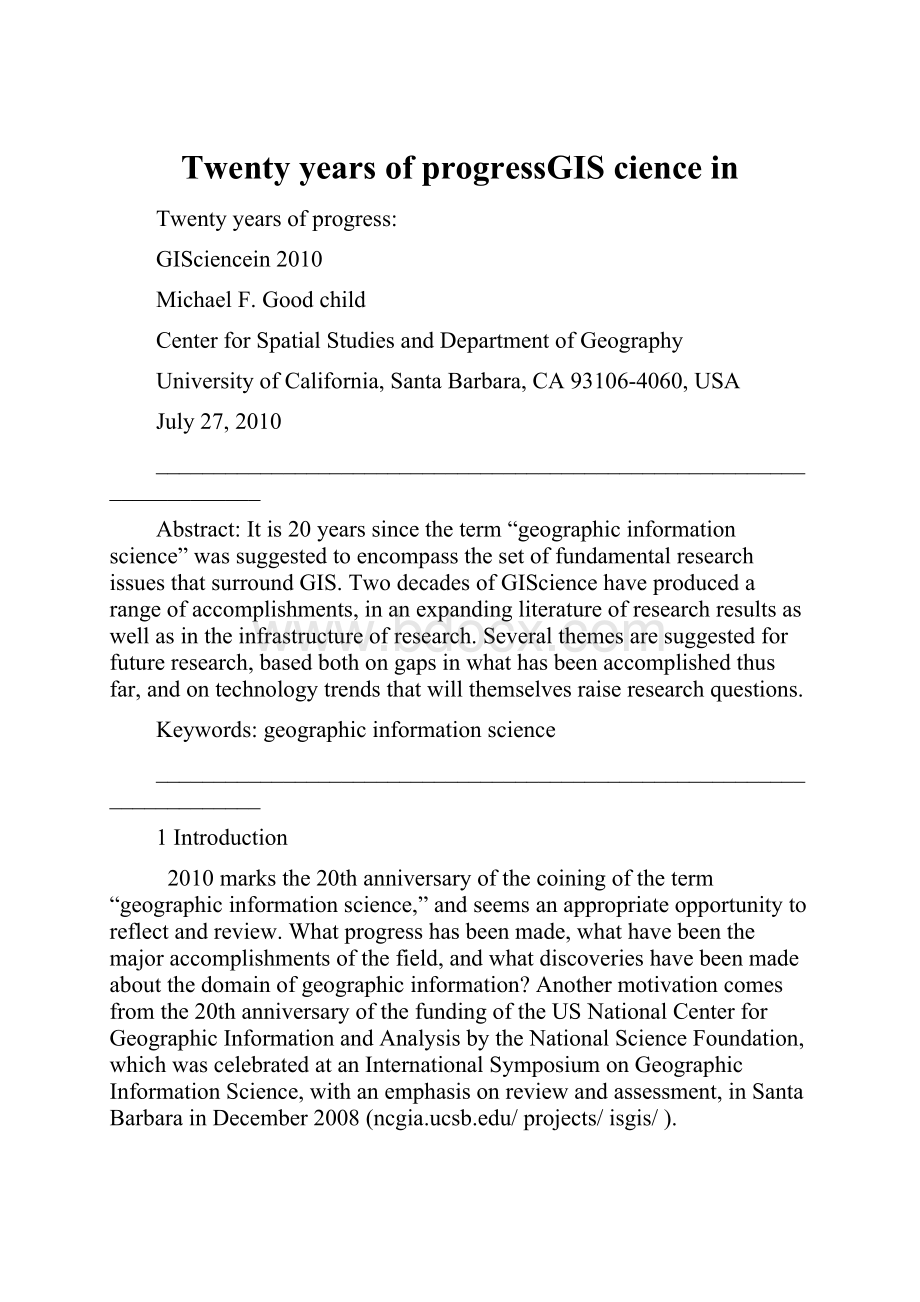Twenty years of progressGIS cience in.docx
《Twenty years of progressGIS cience in.docx》由会员分享,可在线阅读,更多相关《Twenty years of progressGIS cience in.docx(25页珍藏版)》请在冰豆网上搜索。

TwentyyearsofprogressGISciencein
Twentyyearsofprogress:
GISciencein2010
MichaelF.Goodchild
CenterforSpatialStudiesandDepartmentofGeography
UniversityofCalifornia,SantaBarbara,CA93106-4060,USA
July27,2010
_____________________________________________________________________
Abstract:
Itis20yearssincetheterm“geographicinformationscience”wassuggestedtoencompassthesetoffundamentalresearchissuesthatsurroundGIS.TwodecadesofGISciencehaveproducedarangeofaccomplishments,inanexpandingliteratureofresearchresultsaswellasintheinfrastructureofresearch.Severalthemesaresuggestedforfutureresearch,basedbothongapsinwhathasbeenaccomplishedthusfar,andontechnologytrendsthatwillthemselvesraiseresearchquestions.
Keywords:
geographicinformationscience
_____________________________________________________________________
1Introduction
2010marksthe20thanniversaryofthecoiningoftheterm“geographicinformationscience,”andseemsanappropriateopportunitytoreflectandreview.Whatprogresshasbeenmade,whathavebeenthemajoraccomplishmentsofthefield,andwhatdiscoverieshavebeenmadeaboutthedomainofgeographicinformation?
Anothermotivationcomesfromthe20thanniversaryofthefundingoftheUSNationalCenterforGeographicInformationandAnalysisbytheNationalScienceFoundation,whichwascelebratedatanInternationalSymposiumonGeographicInformationScience,withanemphasisonreviewandassessment,inSantaBarbarainDecember2008(ncgia.ucsb.edu/projects/isgis/).
Anyefforttoreflect,andtoreviewthevastrangeofaccomplishmentsofthepast20years,isinevitablysubjectivetosomedegree,reflectingthepersonalopinionsoftheauthor,thoughcomparativelyobjectivesourcescanbefoundinthepublicationsandcitationsofthefield,andintheinstitutionsthathaveemerged.Withthatinmind,thispaperisintendedmoreasastimulustootherstoreflect,anddoesnotpretendtobeentirelyobjective.
Thepaperisstructuredinthreesections.ThefirstmajorsectiondescribesthebeginningsofGIScience,earlydefinitionsofthefieldandeffortstodefinearesearchagenda,andthedebatesandcontroversiesthatinevitablyfollowed.Thesecondsectionreviewsaccomplishments,firstandprimarilyfromtheperspectiveofachievementsinresearch,butalsothroughadiscussionofinstitutionaldevelopmentsandbroaderimpacts.Thethirdandlastmajorsectionlookstothefuture,andpresentsafewthoughtsabouttheworldofgeographicinformationsystemsandtechnologiesthatislikelytoemergeinthenexttenyears.Inadditiontoitsfocusonpersistent,general,andfundamentaltheory,thefieldofGISciencehasalwaysbeendriventosomedegreebytechnology,sofuturedevelopmentswillneedtobeexaminedfromthreeperspectives:
first,whatresearchwillbeneededtoensurethatnewdevelopmentsarefeasible;second,whatresearchwillnewtechnologiesstimulate;andthird,whatissuesofasocialorethicalnaturewillnewtechnologiesraise,andhowshouldtheresearchcommunityrespond?
2Beginnings
2.1GIS:
Toolorscience?
Itiseasytoadvancearigorousdefinitionofgeographicinformation:
toqualify,afactmustlinksomepropertytoalocationonorneartheEarth’ssurface,andpossiblytoapointintimeoratimeinterval;geographicinformationissimplyacollectionofsuchfacts.Butthenotionthattheremightbefundamentalissuesassociatedwithgeographicinformation,andthatthesemightbestudiedinascientificmanner,aroseonlysporadicallyandinwidelyscatteredfields.Geodesy,forexample,requiresasystematicandscientificallybasedapproachtotheproblemofaccuratelymeasuringpositiononaplanetthathasacomplex,non-sphericalshapeandasimilarlycomplexgravityfield;itiseasy,therefore,tomakethecaseforageodeticscience.Cartographyalsodealswithgeographicinformation,butinamannerthatcombinesthescientificwiththeartistic.Photogrammetryismorelikelytobeidentifiedasabranchofengineeringthanasascience,sinceprogressreliesonfindingsolutionstoaseriesoftechnicalproblems.
Geography,thedisciplinethatstudiesthesocialandenvironmentalphenomenaofgeographicspace,haslongstruggledwiththequestionofwhetheritisascience.Amovementthatbeganinthe1950sandflourishedmostnotablyattheUniversityofWashingtonarguedthatgeographycouldindeedbeascience,andcouldaddressitssubjectmatterwithquantitativetools.Bunge’sTheoreticalGeography[6]isoneofthemostpersuasiveandcompellingstatementsoftheargument.Isummarizeditina2008essayinacollectionofkeytextsinhumangeography[30]as:
“thatgeographyisascience;thateveryscienceisdefinedbyitsdomainof
knowledge,whichforgeographyistheEarthasthehomeofhumanity;that
everysciencehasbothafactualorempiricalsideandatheoreticalside;andthat
‘therearemanybooksongeographicfactsandnoneontheory’[6,p.x].”
Geographicinformationsystems(GIS),acointermedinthe1960s,hadevolvedbythelate1980sintoawidelyadoptedsoftwareapplication.ThescientificcommunityhadbeeninvolvedfromthestartinsolvingthetechnicalproblemsofbuildingaGIS,includingthedesignofdatastructures[46]andalgorithmsforexecutingsimpleoperationssuchastopologicaloverlay.Butthenotionthattheremightbeascienceofgeographicinformationtooklongertotakeroot[55],andinsomequartersthedebatecontinuestoday.
ThefirstindicationthattheremightbefundamentalissuesassociatedwithGIScameinthemid1980s,whenRonaldAblerandothersbegantoadvocatetheestablishmentofanationalcenterintheUSwithfundingfromtheNationalScienceFoundation.Thesolicitationthatappearedin1987,followingextensivediscussionwiththeresearchcommunity,includedfivepotentialresearchareas:
spatialanalysisandspatialstatistics;spatialrelationshipsanddatabasestructures;artificialintelligenceandexpertsystems;visualization;andsocial,economic,andinstitutionalissues[1,43].Thefiveoverlappedthedomainsofmanytraditionaldisciplines,includinggeography,statistics,computerscience,cartography,economics,andpoliticalscience,butbroughtthemtogetherinanovelmultidisciplinarymix.
DavidSimonett,PrincipalInvestigatorofthewinningbidforthecenterfromaconsortiumoftheUniversityofCalifornia,SantaBarbara,theStateUniversityofNewYorkatBuffalo,andtheUniversityofMaine,hadlongbeenconcernedwiththelackoftheoryinhisowndiscipline,remotesensing,andwithitsoverwhelmingconcernwiththedevelopmentoftechnology.Inhisviewthisleftthefieldvulnerabletoattackfrommoretheory-orienteddisciplines,andliabletoberelegatedtosecond-classstatusintheacademy.HowmightscientificresearchaboutthefundamentalissuesassociatedwithGISachievethekindofstatusneededforelectiontotheUSNationalAcademyofSciences(NAS),forexample,oritsequivalentinothercountries?
Therewasmuchdiscussionofthisissueamongthecenter’sleadershipinitsearlyyears.
Inthesummerof1990Iwasinvitedtogiveakeynoteaddressatthe4thInternationalSymposiumonSpatialDataHandling,abiennialconferenceseriesthathadbeeninitiatedbyDuaneMarbleandothersattheUniversityofWashingtonin1984.ArgumentsoverGISassciencewereverymuchonmymindwhenIwrotethetextofthekeynoteinStLuciaearlyin1990(notethereferencetotapes,sincedatadisseminationinthiserawasstilldominatedbythe2400ftreelofhalf-inch-wide9-trackmagnetictape):
“What,afterall,isspatialdatahandling?
Itmaydescribewhatwedo,butitgives
nosenseofwhywedoit.Itsuggeststhatspatialdatais(sic)somehowdifficult
tohandle,butwillthatalwaysbeso?
Itsuggestsalevelofdetachmentfromthe
datathemselves,asiftheUSGSweretosendouttapeslabeledwiththegeneric
warning“handlewithdifficulty”...Weareconcernedwithmuchmorethanthe
merehandlingandprocessingofdata.WearemorethantheUPS(UnitedParcel
Service)ofGIS.”[24,p.3]
Instead,IarguedthatthecommunityofresearchersinterestedinGISshouldseeitselfasfocusingonaspatialinformationscience,andtitledthepaperaccordingly.IlaidoutaseriesoffundamentalissueswhichifaddressedscientificallymightqualifyaproductiveresearcherformembershipintheNAS.
AsecondkeynoteinasimilarveinattheSecondEuropeanGISConferencein1991fleshedoutmyideasforaresearchagenda,andincludedthefirstreferencetoa“geographicinformationscience”.Itexpressedcautionovertheresearchagenda,arguingthattheposingofaresearchquestiondidnotnecessaryguaranteeusefulresults:
“Rapidprogresswasmadeonalgorithmsanddatastructuresinthe1970s
and1980s,butmanyofthehardproblemsofdatamodeling,errormodeling,
integrationofspatialanalysis,andinstitutionalandmanagerialissuesremain.
Someofthesemaybeunsolvable—forexample,theremaysimplybeno
generalitiestobediscovered(about)theprocessofadoptionofGISby
governmentagencies,howevereasyitmaybetoposetheresearchquestion.”
[25,pp.342–350]
ShortlythereafterTerryCoppock,editorofthenewInternationalJournalofGeographicalInformationSystems(IJGIS),askedmetobringthetwokeynotestogetherinasinglepaper[26].Ititledthepapergeographicalratherthanspatialinformationsciencefortworeasons.First,IwasintriguedbytheambiguityitimpliedaboutthedecodingofGIS(otherauthorshavesincesuggestedthattheSmightstandforservicesorstudiesaswellassystemsorscience).Second,its